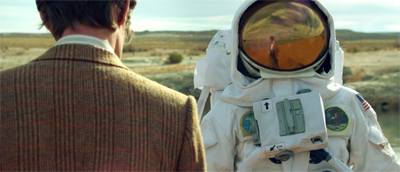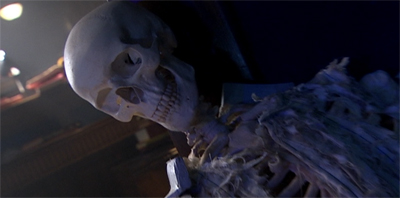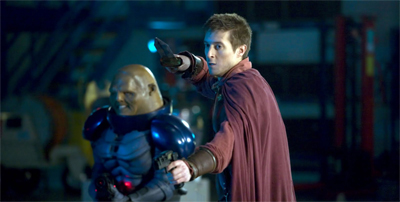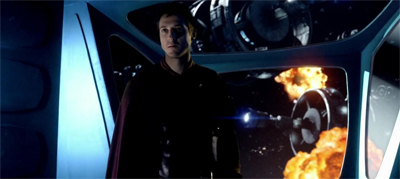It goes without saying that The X-Files was a massively influential television show. As early as its second season, the show had launched all manner of imitations and copycats, both inside and outside the Fox Network. It seems quite likely that Fox invested two-and-a-half million dollars in the failed Doctor Who relaunch of 1996 in the hopes of spinning off another cult/mainstream science-fiction hit like The X-Files. It was launched as a two-hour television movie, failing to earn the rating necessary to spin it off into a weekly series.
However, although the 1996 telemovie provides an obvious point of intersection between The X-Files and Doctor Who, the influence of The X-Files can perhaps be most keenly felt in Steven Moffat’s work on the relaunched television series. Moffat is credited as the producer who helped the show to “break” America during his second year as showrunner, and he did so in a number of ways. Perhaps the most interesting is that he leaned rather heavily on The X-Files as a point of cultural intersection.
Russell T. Davies managed the impossible in 2005. He brought Doctor Who back from cancellation and managed to make it one of the most popular and influential shows on British television. The series inspired a renaissance in British televised fantasy, spawning a rake of imitators as any successful show inevitably does. Recruiting British thespian Christopher Eccleston – and later breakout star David Tennant – Davies made the show must-watch television. He earned awards for this work, securing high ratings and rave critical reviews.
Davies’ blueprint for the revival of Doctor Who seemed to be Buffy: The Vampire Slayer – a show that Davies himself acknowledged as an influence. Even Davies’ spin-off Torchwood, which would seem like a logical place to spot some influence from The X-Files, seemed to draw more from Buffy. When Davies brought the show to the United States, he recruited X-Files veteran John Shiban and Buffy alumni Jane Espenson. Shiban co-wrote one episode, and fully scripted another. Espenson is credited on half the season, including the finalé.
Since taking over the running of Doctor Who, Moffat has suggested the show has moved past Buffy. However, while The X-Files was at best a minor influence on Davies’ Doctor Who revival, it was much more prominent an influence in the work of Davies’ successor, Steven Moffat. Moffat came to prominence towards the end of the eighties, launching Press Gang in 1989. However, his defining career moments came in the nineties – his five-year stint writing Joking Apart, his short-lived Chalk, and the development of Coupling, leading to its launch in 2000.
In short, Moffat’s career was almost perfectly positioned so that he might be influenced by The X-Files – the American import that went down a storm in the United Kingdom. It is hard to undersell just the impression that The X-Files made in Britain. The X-Files was initially aired on BBC Two, the traditional home for cult US television shows, before being moved to BBC One mid-way through its second season. It had official magazines and merchandise, video cassette releases. It was one of the primary selling points for Rupert Murdoch’s young Sky network.
One can see the influence of The X-Files in some of Moffat’s writing for Doctor Who even before he took over the showrunner gig. Most obviously, his final two-parter written during the tenure of Russell T. Davies shares quite a few cues with Darkness Falls. In Silence in the Library and Forest of the Dead, it is revealed that ancient hungry microbes lived inside trees harvested to produce the books in a major galactic library. Darkness Falls hits on many similar ideas, with logging awakening similarly hungry monsters.
“These are our forests,” the disembodied vashda nerada claim in Forest of the Dead. The fluorescent green parasites in Darkness Falls lack the same ability to articulate, but one imagines that they feel quite similar. The green bugs in Darkness Falls feed on their prey until there is little left. The vashda nerada leave nothing behind but the bones of their last meal. There are significant similarities there.
Then again, it makes sense. For the first four seasons of the revived Doctor Who, Steven Moffat was the guy you could count on for the scary stuff. His scripts tended to make the most unsettling and frightening of episodes. Gas mask zombies asking “are you my mummy?” A space-ship powered by organs harvested from the crew. Killer statues that could only move when the characters (and the audience) weren’t looking. It is easy to see why The X-Files might have serves as an effective touchstone for Moffat’s work on Doctor Who.
There are also some interesting parallels with Moffat’s “other” iconic and influential twenty-first century BBC television show. Sherlock owes a considerable debt to The X-Files, most obviously in the dynamic between Sherlock Holmes and John Watson – the crime-solving due who share a much more personal bond. Sherlock is even introduced as a potential “spy” on Sherlock, as Mycroft tries to convince the former soldier to report back on his errant brother.
The show has consciously played up the bond between Watson and Holmes. “It’s always definitely a love story,” Moffat quipped on the commentary to Hounds of the Baskervilles. He went on to define the relationship in terms that will seem familiar to any fans of The X-Files. “Sex is not really the issue among any of these people. Love is. Infatuation is. I think John Watson is infatuated with and fascinated by Sherlock Holmes. I think Sherlock Holmes absolutely relies completely and utterly on John Watson and is devoted to him.” Swap the names, and that’s Mulder and Scully.
Again, there are also more specific references to be acknowledged here. The second season finalé of Sherlock touches on the “death” of the famous detective. The Reichenbank Falls was clearly inspired by The Final Problem, the story where Sir Arthur Conan Doyle had Moriarty and Holmes fall over a waterfall together, killing the detective off… for a little while at least. However, The Reichenbank Fall deviates quite substantially from the source material, instead borrowing quite heavily from Gethsemane, the fourth season finalé of The X-Files.
Rather than falling over the edge while locked in a mortal battle with Moriarty, the climax of The Reichenbank Fall finds Moriarty already dead. Instead, Holmes jumps in what is framed as a suicide. He is alone, disgrace and publicly discredited. The show closes with Holmes leaping from the roof to what appears to be certain death. This is quite similar to the position that Mulder finds himself in Gethsemane, confronted with evidence that he has been set up and that everything he ever believed was a lie. The episode closes with Mulder’s suicide.
Of course, both The Reichenbank Fall and Gethsemane count on the viewer being smart enough and shrewd enough to realise that this is all a set-up. The question isn’t whether the hero has given into all that pressure and killed themselves. The question isn’t even how they faked it. Both of the episodes following on from these cliffhangers are relatively relaxed about the finer details of how this hoax was carried out and how the authorities were fooled for as long as they were. They also rely on convenient information hidden from the audience to explain how this happened.
The real question posed by both The Reichenbank Fall and Gethsemane is about what happens next. Both moments are set up to look like plot beats, but are twisted around to become character beats. The third season of Sherlock is even more driven by character than the first two. The fifth season of The X-Files presents us with the story of how Mulder lost his faith in the little green men he had been chasing his whole life. The individual similarities are trivial of themselves, but they add up to a larger picture.
However, the biggest influences of The X-Files on Moffat’s work are arguably to be found in his tenure as producer of Doctor Who. Moffat has described himself as a “box set man”, and has adopted a more long-form approach to storytelling than his direct predecessor. Davies tended to block out individual seasons ahead of time, while the entirety of Moffat’s run can be charted as a single extended narrative unfolding between “monster-of-the-week” adventures. It is a format quite similar to the one pioneered by The X-Files in the nineties.
While these similarities are loose enough to be written off coincidence – The X-Files did not invent cross-season arc-based storytelling, even if it did popularise it – the similarities became more pronounced as Moffat’s run went on. In particular, Moffat’s second season (the sixth season since the show came back) draws quite heavily from the iconography and imagery of The X-Files. This makes a great deal of sense, given that one of the more aggressive goals of that season had been to establish Doctor Who in North America.
In many respects, The X-Files is the most logical source of inspiration. The show straddled “cult” and “mainstream” in the same way that the revived Doctor Who has done. Although The X-Files attracted some devoted followers, it also appealed to a much broader audience. It retained its unique flavour and identity – and narrative density – while becoming one of the most popular shows on television. It was a densely-plotted piece of genre fiction, but one that was also accessible and popular in a way that even Buffy wasn’t.
This is the same balance that Moffat found himself trying to maintain with Doctor Who. It had the DNA of a cult show. It was genre television, adapted from a cancelled series that had dwindled in popularity and faded from the public mind before. However, it had been brought back in a way that made it massively popular and iconic. Moffat wanted to play with some of the more esoteric elements without alienating too many of the casual viewers. As such, The X-Files was the perfect model for what Moffat wanted to do, even before one considers America.
During the Davies’ era, Doctor Who had been treated as a low-key science-fiction import on American television. The Sci Fi Channel did not get around to airing the first season until March 2006. The network also had to edit the episodes to fit in its commercials. Over the next four years of the show, the situation improved dramatically – but there was still a distance. The fourth season of the revived show aired on Sci Fi only a few weeks behind the initial UK airdates. The specials bridging the fourth and fifth seasons aired on BBC America a day after their initial British broadcast.
Davies secured Doctor Who on British television schedules. The end of his final full season as producer was the most watched show on British television that week – cementing Doctor Who as the biggest thing on British television. This success allowed his successor to turn his attention towards establishing the show in America. While Moffat’s first season as producer remained relatively faithful to the model established by Davies, he was a bit more confident when it came to his second year as showrunner.
The sixth season of the revival made a conscious effort to court American viewers. The cast and crew were a massive presence at Comic Con. It was announced that the gap between British and American broadcasts would be narrowed to a few hours – with Doctor Who airing on the same day in the US and the UK. Most importantly, the sixth season actually filmed extensively in the United States, with the main cast flying over to film The Impossible Astronaut and Day of the Moon in Utah.
While Evolution of the Daleks and Daleks in Manhattan had done some second unit work in New York, they had not taken the primary cast over. The episodes of the third season set in New York were mostly filmed on British sound stages. Moffat had actually taken the show to America, making a point to film the episodes set in America in the country. When even the 1996 television movie had to substitute Vancouver for San Francisco, Moffat had the real deal at hand.
This model worked very well, with the show pushing these successful initiatives even further. While the third episode of the next season, A Town Called Mercy, was a Western filmed in Spain, the mid-season finalé, The Angels Take Manhattan, was shot in New York. The show’s fiftieth anniversary special, The Day of the Doctor, was broadcast simultaneously in the United States. The infamous eighth season leaks were sourced to a Miami office where BBC had been translating the show into Spanish in order to extend the show’s audience even further.
All of this is just background information, though. What is relevant is that Moffat seemed to draw quite heavily on The X-Files as an influence when trying to court an American audience for Doctor Who. In particular, the sixth season of Doctor Who draws quite heavily from the conspiracy iconography and imagery that The X-Files really pushed into the popular consciousness. There are aliens that resemble the aliens of American UFO folklore. There are men in black. There is Nixon. There is abduction. There is a secret history of mankind building towards colonisation.
The Impossible Astronaut and Day of the Moon are an obvious starting point, introducing “the Silence.” Initially appearing to be a new species of alien, “the Silence” are actually a secret cabal engaged in quite a few needless complicated (and somewhat jumbled) plots against mankind. They are revealed to be involved in a byzantine scheme to kill the Doctor, spanning across the entirety of Matt Smith’s tenure in the title role. For the purposes of The Impossible Astronaut, it is revealed that they have been controlling the world for centuries from behind the scenes.
The Silence feel like an amalgam of various bits of conspiracy mythology, pulling together bits of UFO folklore into one cohesive package. Like most conspiracy theory aliens, the Silence have been on Earth for a very long time. Their bulbous heads resemble the iconic “greys” of UFO mythology, and they wear the costumes of Men in Black, while possessing the ability to make people forget that they even exist. They have been operating in the shadows for eons, taking credit for all of mankind’s accomplishments since fire – parasitically exploiting mankind as part of a larger scheme.
These are all themes and ideas that resonate with The X-Files, a show that presented its own conspiratorial view of American history as guided by a sinister and self-serving cabal with secret agendas and ominous goals. The Impossible Astronaut even features Nixon as a supporting character, drawing in the United States President most closely associated with the loss of faith in the American government. The Silence’s ability to manipulate history (and erase themselves from it) reflects the tendency of The X-Files, to weave its own story in the spaces between real events.
Of course, Moffat seems to be having a bit of fun with the idea of these sorts of long-reaching conspiracies – acknowledging the inherent absurdity and convoluted nature of such things. In Matt Smith’s final episode, The Time of the Doctor, the entire plot to assassinate the Doctor is dismissed in a few lines of dialogue, as if Moffat is glibly teasing fans expecting a more involved or concrete resolution. Even in The Impossible Astronaut, it is revealed that the Silence have been manipulating the entirety of human history… in order to build a space suit.
It’s a ridiculously absurdly over-the-top scheme, and one that draws attention to nonsensical nature of many conspiracy theories. The space suit doesn’t even seem particularly essential to the plan at hand. It seems that there would likely be lots of other pieces of technology that could just as easily have filled the same (relatively minor) niche in the larger overall plan of assassinating the Doctor. It is an unnecessarily convoluted scheme with a ridiculously unambitious pay-off, quite like a lot of conspiracy theories.
There are other obvious parallels to be seen. At the climax of The Impossible Astronaut, the Doctor’s red-haired companion is abducted. Amy is taken away by the Silence for experimentation. Even ignoring the imagery used, the parallels to Scully’s abduction are obvious. While Scully’s abduction was forced by Gillian Anderson’s pregnancy, creating a reproductive subtext to the abduction that was subsequently confirmed by later episodes, Moffat writes the subtext into the script for The Impossible Astronaut. Actress Karen Gillen is not pregnant; character Amy Pond is.
Amy Pond’s body is cynically used and cruelly exploited for the purposes of a sinister conspiracy, much as Scully’s body also was. After Scully is returned, it is discovered that the experiments were reproductive in nature – that her DNA was used to create new life without her consent and that she was rendered barren. The plot against Amelia Pond is also reproductive in nature. The Silence plot to harvest Amy’s child (having kidnapped her when pregnant) and then use that child as a weapon in their on-going war.
Of course, the fact that Karen Gillen was not pregnant while shooting the season means that the actress was more available during this plot than Gillian Anderson had been during her own abduction plotline. Although Amy spends the first half of the season abducted and experimented upon by aliens, she also remains a prominent part of the series, even before the Doctor mounts a rescue mission. Moffat simply reveals that the Doctor was traveling with a doppelganger clone of Amy. The wonders of science-fiction plotting.
However, while The Impossible Astronaut draws its broad strokes from the larger mythology of The X-Files – or, rather, draws on the same iconography and imagery that informed that mythology – things get a little bit more specific when Moffat brings the “Amy abduction” plot to a head. A Good Man Goes to War, the mid-season finalé of the sixth season, owes a rather conscious debt to One Breath. As the Doctor and Rory mount a rescue mission to recover Amy, they are both confronted with the uselessness of simple vengeance.
The Doctor might engage in a rip-roaring-rampage of revenge against those who kidnapped his friend and sought to steal her child, but A Good Man Goes to War points out the futility of that sort of vengeance. The Doctor manages to storm the secret headquarters and secure the base, getting in a few nice pieces of showboating and boasting as he humiliates his foes. However, in doing so, the Doctor seems to justify the campaign against him. And all his bluster is ultimately revealed to be useless; he is unable to save Amy’s child. She is still taken, and still turned into a weapon.
In many respects, this feels like a conscious mirror of Mulder’s arc in One Breath, as the male hero is forced to confront the inadequacy of violence and revenge as a response to terrible atrocities. Much as the Doctor is unable to save Melodi Pond from the Silence, Mulder is unable to exact justice from the conspiracy. All that the Doctor and Mulder can hope to do is engage in the healing process. The Doctor works hard to redeem and to heal the adult River Song, rather than seeking retribution against her captors, much as Mulder realises his place is at Scully’s bedside.
In both cases, the male hero is forced to accept that their own response to the violence perpetrated against their close friend is secondary to the well-being and healing of the victim. Amy and Scully are the characters who have been harmed by these transgressions, and they are the characters who will have to deal with the scars from these encounters. Both One Breath and A Good Man Goes to War see their male heroes realising the folly of the all-too-common rape-revenge narrative and realising that healing is more necessary than fantasies of retribution by proxy.
This is perhaps the strongest thematic link between Moffat’s second season of Doctor Who and The X-Files, a connection that feels even stronger than the iconography and imagery that they share. Given the density of these references and echoes within the sixth season of the relaunched show – and the fact that Moffat was very clearly trying to crack the US market with it – it seems as if the American hit show may have been a major influence on his work. Certainly, it would have been a pretty good choice.
You might be interested in our other reviews of the second season of The X-Files:
- Little Green Men
- The Host
- Blood
- Sleepless
- Duane Barry
- Ascension
- 3
- One Breath
- X-Over: The X-Files & Steven Moffat’s Doctor Who
- X-tra: The X-Cast – Season 2, Episode 8
- Firewalker
- Red Museum
- Excelsis Dei
- Aubrey
- Irresistible
- Die Hand Die Verletzt
- Fresh Bones
- Colony
- End Game
- Fearful Symmetry
- Død Kälm
- Humbug
- X-tra: (Topps) Trick of the Light
- The Calusari
- F. Emasculata
- Soft Light
- X-tra: (Topps) #4-6 – Firebird
- Our Town
- Anasazi
Filed under: Television, The X-Files | Tagged: a good man goes to war, amy, conspiracy, Darkness Falls, doctor who, Forest of the Dead, nixon, one breath, scully, silence, Silence in the Library, steven moffat, vashda nerada, watergate, x-files |






































This was an interesting analysis. I do think that there is one extremely significant difference between Chris Carter on The X-Files and Steven Moffat on Doctor Who, though.
After a while it became apparent that Carter was making everything up as he was going along, that he did not have any overarching long-term plan, and that the puzzle pieces he was tossing out could never be assmbled into anything remotely approaching a coherant image. That is why I finally got fed up with The X-Files after about six seasons, because it became apparent that the show was running in circles with the alien conspiracy plotlines, and we were not going to recieve any sort of answers that made sense.
In contrast, Moffat for all his complicated plotting almost invariably knows exactly where he is going, and sooner or later his various subplots do pay off. Things get resolved, character & story arcs come to a close. Some might argue about the level of quality to those resolutions, but they are there.
Yep, that’s a veyr big difference. But I can’t help but wonder if Moffat wasn’t influenced by The X-Files. I know there was (and is) a huge fandom overlap between the two. In particular, the structure of Season Six quite resembles the old mythology/standalone divide that The X-Files loved so much. (Open with mythology, then random adventures, then mythology two-parter, then random adventures with some thematic elements from the mythology, then mythology conclusion.)